Afterword

Afterword
Peitho Volume 25 Issue 4, Summer 2023
Author(s): Shirley Wilson Logan, Cheryl Glenn, and Andrea Lunsford
Shirley Wilson Logan is a professor emerita of English at the University of Maryland and the author of We Are Coming: The Persuasive Discourse of Nineteenth-Century Black Women and Liberating Language: Sites of Rhetorical Education in Nineteenth-Century Black America. She specializes in nineteenth-century African American rhetoric, with an emphasis on women’s oral and written performances. She has published several individual essays on women from this period, including Ida Wells, Anna Julia Cooper, Victoria Matthews, and Frances Harper, as well as critical examinations of the rhetorical activities of black men and women across the nineteenth-century. Logan has also published a number of essays on approaches to teaching writing in twentieth- and twenty-first century multilingual classrooms, including studies of the impact of rapidly evolving technologies. Professor Logan is co-editor of the Southern Illinois University Press series Studies in Rhetorics and Feminisms. The series has published seventeen titles, over the past twelve years, of both traditional and cutting-edge scholarly works exploring relationships between rhetoric and feminism within various genres, cultural contexts, historical periods, methodologies, theoretical positions, and methods of delivery.
Cheryl Glenn is Distinguished Professor of English and Women’s Studies (Emerita), former Director of the Program in Writing and Rhetoric, and co-founder of Penn State’s Center for Democratic Deliberation. Professor Glenn’s scholarly work focuses on histories of women’s rhetorics and writing practices, feminist theories and practices, inclusionary rhetorical practices and theories, and contexts and processes for the teaching of writing. Her many scholarly publications include Rhetoric Retold: Regendering the Tradition from Antiquity Through the Renaissance; Unspoken: A Rhetoric of Silence; Rhetorical Feminism and This Thing Called Hope; Silence and Listening as Rhetorical Arts; Rhetorical Education in America; The St. Martin’s Guide to Teaching Writing; The Writer’s Harbrace Handbook; Making Sense: A Real-World Rhetorical Reader; The Harbrace Guide for College Writers; Harbrace Essentials; Landmark Essays on Rhetoric and Feminism, and numerous articles, chapters, and essays. She and Stephen Browne co-edit “Rhetoric and Democratic Deliberation,” a Pennsylvania State University Press series. With Shirley Wilson Logan, she co-edits the Southern Illinois University Press series, “Studies in Rhetorics and Feminisms.”
The Louise Hewlett Nixon Professor of English Emerita, Claude and Louise Rosenberg Jr. Fellow, and Former Director of the Program in Writing and Rhetoric, Andrea Lunsford has designed and taught undergraduate and graduate courses in writing history and theory, rhetoric, literacy, and intellectual property. Professor Lunsford’s interests include rhetorical theory, women in rhetoric, collaboration, cultures of writing, style, the graphic novel, and technologies of writing. She has written or coauthored nineteen books including The Everyday Writer; Essays on Classical Rhetoric and Modern Discourse; Singular Texts/Plural Authors: Perspectives on Collaborative Writing; and Reclaiming Rhetorica: Women and the History of Rhetoric, as well as numerous chapters and articles. Her most recent books include Writing Matters: Rhetoric in Public and Private Lives, Writing Together: Collaboration in Theory and Practice (with Lisa Ede), The Sage Handbook of Rhetorical Studies (editor), and Everyone’s an Author. She is currently the general editor of The Norton Anthology of Rhetoric and Writing, forthcoming.
First, a big bravx to Aurora Matzke, Louis Maraj, Angela Clark-Oates, Anyssa Gonzalez, and Sherry Rankins-Robertson for their keen insights into the complex issues surrounding coalition-building–and their resolute persistence in envisioning and producing this special issue of Peitho. Their introduction traces the discussions and debates, the sometimes labyrinthine contact zones, that have characterized the CCCC Feminist Workshops—and Coalition meetings–during the last three years (2021-23). These contact zones have led to the strong desire to invite more new and diverse voices into the conversation and to search for new ways of understanding, modeling, and interrogating coalitional efforts—especially to examine both “the dangers and possibilities of coalitions” (Chávez, in this collection).
The authors in this special issue speak to these goals, from Karma Chávez, who examines the risks and opportunities encountered in attempts at academic coalition-building, and Keisha Mcclantoc, who describes coalition-building in rural organizations and suggests lessons we might learn from their leaders to Rachel Molko, who argues that feminist iconography can not only depict but enable opportunities for coalitional solidarity. A group of George Washington University Writing Program Faculty direct our attention to methods for sustaining values associated with forming coalitions rather than centering the purpose of such groups, while Lydia McDermott tells stories designed to bring attention to “radical coalitional accessibility.” The importance of feminist humility, empathy, and unlearning are featured in the essay by Asmita Ghimire, Amy Lueck, and Elizabethada Wright on transnational feminist mentoring.
We are grateful to these and the other authors of this issue for providing so much food for thought, especially given the attention they have all paid to the various “coalitions” they have experienced, historicized, or imagined. In this afterword, we trace some of the through lines we see emerging from this work, including the radical, strategic, and necessary temporariness of coalitions, their thoroughly rhetorical feminist nature, the role that stories and vernaculars play in their shifting constructions, the relationship between coalition and collaboration, and potential sites for feminist temporary coalition building that have seldom been considered.
Nearly ten years ago, Cheryl and Andrea meditated on the concept of “coalition,” writing that it “denotes a group of distinct individuals who come together to cooperate in joint action toward a mutual goal (or set of goals)–not forever, but for however long it takes” (Glenn and Lunsford 11). To forge any kind of feminist coalition–across differences of every stripe–is to strive toward goals that are dialogic, collaborative, and inclusive. A coalition is a conceptual action, a trope that can be used to help negotiate cross-boundary mis/understandings and reconciliations as well as illuminate and advance possibilities.
As such, a coalition is a living, breathing, permeable, ever-changing group of individuals. A coalition is not an iron-clad, life-long allegiance. Consider the nearly five million activists who came together for the 2017 Women’s March on Washington, the worldwide protest held on the day after the inauguration of Donald Trump as U.S. president. In cities all around the world, people coalesced for one day to advocate for human rights of every kind, after which they returned home. The 2017 Women’s March was not a kumbaya day. Among the activists, there was internal division, despite photos like the one below that suggest unity.
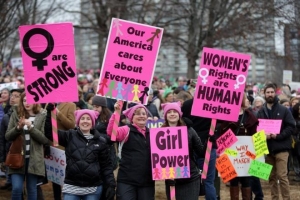
Participants at 2017 Women’s March suggesting unity
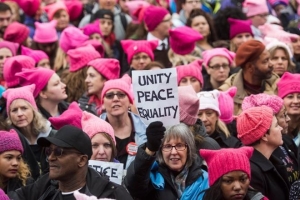
Other signs appeared, challenging any such unity and illustrating the true nature of strategic, temporary coalitions.
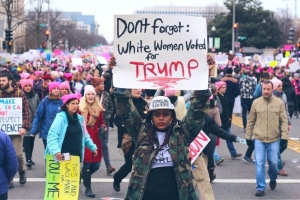
Figure 3 & 4: Participants at 2017 Women’s March acknowledging the lack of unity
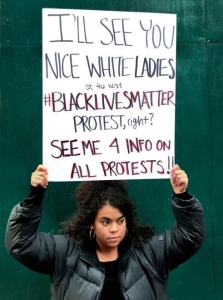
As these placards demonstrate, coalitions are living, breathing organisms—they are born, they evolve, and sometimes they die. They are ever-responsive, ever-changing, ever-strategic—and ever unstable. That’s why they’re called “coalitions.” Coalitions value “togetherness in difference” (to use Lu Ming Mao’s powerful phrase) and are devoted to action—not nonstop action, but strategic action. All of us need to understand these variables so that we can work equitably and effectively with a range of differing others.
To examine one of the most iconic photos of second-wave feminism, the 1971 photograph of Gloria Steinem and Dorothy Hughes that has since been repeated multiple times, is to imagine a Black-and-white coalition, even a solidarity that is repeated over time. (See the fine essay in this issue by Molko.) Indeed, Black and white feminists have long been working side-by-side toward specific goals, except when they purposefully worked separately.
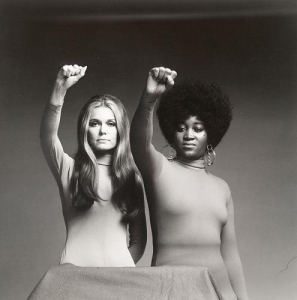
Figure 5: Gloria Steinem and Dorothy Pitman Hughes, 1971, Dan Wynn
Also consider the 1974 Combahee River Collective, who produced a living manifesto in 1977. These women broke away to “publicly address” the “racism in the white women’s movement”:
As Black feminists we are made constantly and painfully aware of how little effort white women have made to understand and combat their racism, which requires among other things that they have a more than superficial comprehension of race, color, and Black history and culture. Eliminating racism in the white women’s movement is by definition work for white women to do, but we will continue to speak to and demand accountability on this issue. (Combahee River Collective 21)
This socialist collective (not a coalition), organized according to the nonhierarchical distribution of power, worked toward goals that would benefit everyone within the collective itself. These women established a collective because “outside reactionary forces and racism and elitism with the [white feminist] movement itself have served to obscure our participation” (14). After all, they wrote, “We believe that the most profound and potentially the most radical politics come directly out of our own identity, as opposed to working to end somebody else’s oppression” (16). For the Black women in this collective, their cause had already realized that identity-inflected politics and rhetoric expanded the feminist principle that the personal is political. Their work was not coalitional; it was/is collective, ongoing work for the collective good of group members themselves.
Feminist coalitions as well as feminist collectives are deeply rhetorical in nature, in that they embody a keen rhetorical awareness of context as well as to shifting and overlapping contexts (aka intersectionality), an equally careful consideration of varying or alternative perspectives, and an insistence on the possibilities of human agency, often in the case of women and people of color, against all odds. (Dare we say through rhetorical feminism’s commitment to HOPE?) In addition, both feminist coalitions and feminist collectives rely on the rhetorical power of story.
Story–one powerful strategy available to feminist rhetors building temporary coalitions–is the universal genre that all cultures rely on. Once denigrated as irrelevant to scholarship (an editor of College English once rejected an essay by Brenda Brueggemann because it contained too much personal narrative, for example), story (or narrative) is now recognized as a crucial element of connection and persuasion. In Making the World a Better Place: African American Women Advocates, Activists, and Leaders, 1773-1900, Jackie Royster challenges the many reductive and whitewashed narratives related to the stories she has been tracing through the lives of African American women. Building on the foundations she laid in Traces of a Stream with a dozen years of additional research, Royster’s rich and remarkable book shifts the traditional narrative of “exemplary” or “extraordinary” African American women to tell the stories of scores of everyday African American women who worked, individually and collectively, to build and sustain the race and the nation—from the very beginning of their presence in North America to the present day. Moreover, Royster makes sure these women will speak for themselves, telling their own stories, a feminist rhetorical principle she has articulated in earlier work.
Royster often uses “cohort” or “cohorts” to describe the women who come together in shifting and strategic ways, and she favors the use of “collective,” focusing on the ways African American women, in the act of storytelling, model the kind of collective work that creates change across time and space. Most of all, Royster challenges other scholars and thinkers to “interrogate kaleidoscopically what, how, and why they are doing what they are doing; to listen to their words and advice, and to presume that their work might likely have values at the local level but also far beyond” (28). Royster’s text embodies the power of story, or narrative, even as she warns of what Chimamanda Ngozi Adiche has called “the danger of the single story” and the manipulation of story for often dubious ends. In doing so, Royster provides a theoretical and practical foundation for the kind of shape-shifting, temporary, strategic coalitions available to feminist groups today, such as that demonstrated in the special issue and across CCCCs feminist coalition work.
Whether group feminisms is practiced in clubs, collectives, circles, sororities, church women, Boys and Girls Clubs, coalitions, or myriad other formations, members must respect divergent positions within the group, even around common though transient goals. Members must support one another through disagreements and arguments and especially when any member decides the time is right to leave the group. Take, for instance, the example of Pauli Murray (1910-1985), an African American civil rights activist, university professor, lawyer, writer, and, eventually, an Episcopal priest, who provides a salient example of the challenges associated with negotiating attachments to coalitions.
Murray had worked with a group of women, led by Betty Friedan, to establish the National Organization for Women (NOW) in October of 1966. (For more information, see Glenn’s Rhetorical Feminism and This Thing Called Hope.) Murray used her exceptional rhetorical abilities to craft many of their founding documents. But soon after that historic fall event, less than a year later, she withdrew from the leadership, realizing that their interests had grown apart. She was concerned about their growing lack of diversity, with a membership of mostly white, professional women, who seemed more interested in women’s rights than in human rights. Her severance seemed to have been the result of a clash between her personal beliefs and the unchanging goals of the organization. She felt that it was time for her to leave.
Murray’s example demonstrates how members of women-led groups may organize themselves and support their members differently, yet they all have one thing in common: they are organized toward concrete, specific, often transient goals that are reached through a combination of hard work and words. Such groups don’t require lifetime memberships, nor are they life sentences. Rather, these women-led groups are living organisms like the members themselves, who are working hard together to realize goals. And it is in the spirit of temporality, difference, change, and transience that the Peitho 2023 summer special issue emerges.
Read, for example, Fitzsimmons and Prasad’s “Coalitional Refusals” (this issue) for a critique of the “rigged spotlights” that prevent feminist movements from understanding “coalitional tensions, changing needs, and harm when it happens.” They argue, through Cody Jackson and Christina Cedillo, in this collection that “if we’re seeking to build coalitions, we also need to build in practices that identify and address the ways we perpetuate [oppressive] systems, both individually and as a field, a department, or a university” (Fitzsimmons and Prasad). This attention, that may then lead to coalitional refusal, begins with choice. A choice to center coalition on the here and now of nope.
Like rhetoric, these groups are ever-changing, in a constant state of response, reassessment, and self-correction. Thus, such groups tend to be thoroughly rhetorical, instances of rhetorical feminism, a tactic that disidentifies with how things are, considers how things should be, and works toward what “should.” In this issue, rhetorical feminists respect one another’s experiences, emotions, and vernaculars (thus strategically reshaping the rhetorical appeals), their comings and goings. Rhetorical feminists remain dialogic; recognize and respect alternative delivery systems (including silence, listening, and refusal); and anchor themselves and their projects in hope. That’s what feminisms all about anyway, isn’t it? Choice, support, goals, work, and hope?
Works Cited
Combahee River Collective. “The Combahee River Collective Statement: A Black Feminist Statement.” 1977. All the Women Are White, All the Blacks Are Men, but Some of Us Are Brave, edited by Gloria T. Hull, Patricia Bell Scott, and Barbara Smith. Feminist Press at City U of New York Press, 1982, pp.13-22.
Glenn, Cheryl, and Andrea A. Lunsford. “Coalition: A Meditation.” Peitho, vol. 18, no. 1, 2015, 11-14. /docs/peitho/files/2015/11/18.1FullIssue1.pdf
Glenn, Cheryl. Rhetorical Feminism and This Thing Called Hope. Southern Illinois University Press, 2018.
Friedan, Betty. The Fountain of Age. Simon and Schuster, 1993.
Mao, Lu Ming. Reading Chinese Fortune Cookie: The Making of Chinese American Rhetoric. Utah State UP, 2006.
Royster, Jacqueline. Making the World a Better Place: African American Women Advocates, Activists, and Leaders, 1773-1900. University of Pittsburg Press, 2023.
Wynn, Dan. “Gloria Steinem and Dorothy Pitman Hughes.” National Portrait Gallery, 1971, https://npg.si.edu/object/npg_NPG.2005.121. 1 May 2023.
